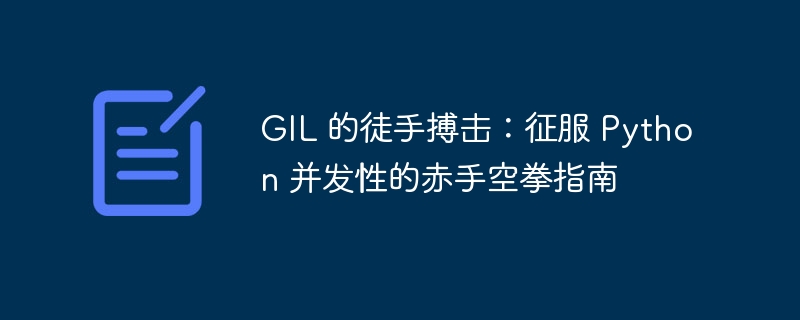Home >Backend Development >Python Tutorial >Hand-to-Hand Combat with the GIL: A bare-knuckle guide to conquering Python concurrency
Hand-to-Hand Combat with the GIL: A bare-knuckle guide to conquering Python concurrency
- WBOYWBOYWBOYWBOYWBOYWBOYWBOYWBOYWBOYWBOYWBOYWBOYWBforward
- 2024-03-02 16:01:36460browse

Hand-to-hand combat GIL
GIL exists to prevent only one thread from executing bytecode at the same time, thereby ensuring data integrity. However, this also results in concurrency being limited since other threads have to queue and wait.
Way to release GIL
There are several ways to release the GIL, allowing other threads to execute simultaneously:
- Use C extension: By writing a C extension module, you can bypass the GIL, thereby improving the performance of concurrency.
- Use native threads: Native threads run at the operating system level and are not subject to the GIL. But special attention needs to be paid to threadsecurity issues.
- Use coroutines: Coroutines are executed in user space and can switch thread execution to avoid GIL obstruction.
- Use multiple processes: Start multiple python processes. Each process runs in an independent memory space and is not affected by GIL.
Demo code:
Let us understand how to release the GIL through a demo code:
import threading import time # 使用原生线程 def worker(): for i in range(10): print(i) time.sleep(1) # 使用 GIL 的线程 def gil_worker(): for i in range(10): with threading.Lock(): print(i) time.sleep(1) # 启动原生线程 t1 = threading.Thread(target=worker) t1.start() # 启动 GIL 线程 t2 = threading.Thread(target=gil_worker) t2.start()
Output:
0 1 2 ... 9 0 1 2 ... 9
In this example, the native thread worker can run concurrently with the GIL thread gil_worker because they are not bound by the GIL.
Best Practices
- Use C extensions or native threads when possible to improve concurrency.
- Use GIL threads with caution and only when absolutely necessary.
- Avoid performing time-consuming operations in the GIL thread.
- Understand the limitations of the GIL and adjust your code as needed.
in conclusion
Fighting the GIL hand-to-hand can be a challenge, but mastering these techniques will allow you to take full advantage of Python's concurrency potential. By releasing the GIL or using alternative methods, you can overcome single-core limitations and unleash the concurrency power of Python to create more powerful, responsive applications.
The above is the detailed content of Hand-to-Hand Combat with the GIL: A bare-knuckle guide to conquering Python concurrency. For more information, please follow other related articles on the PHP Chinese website!

